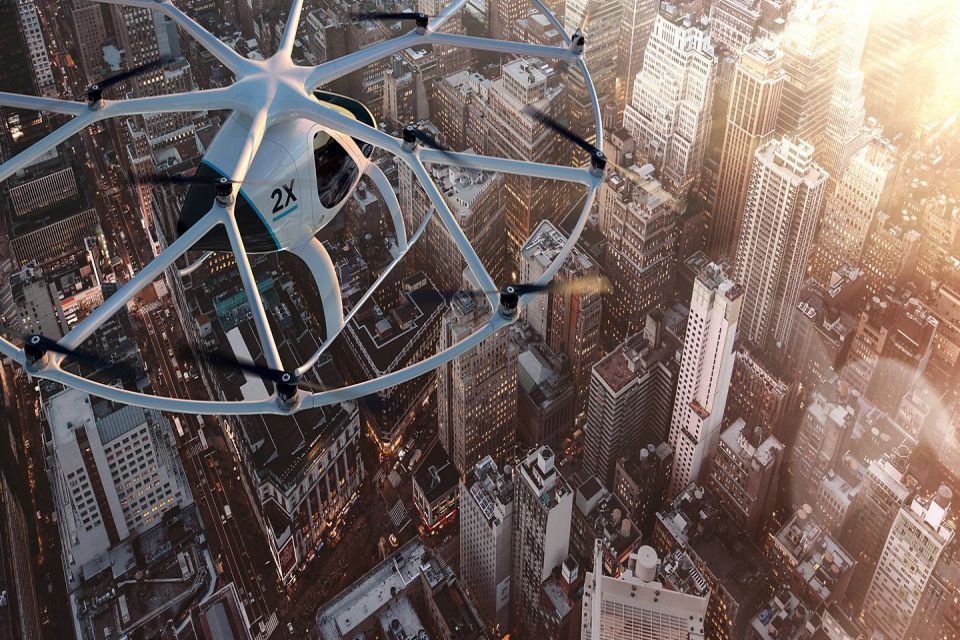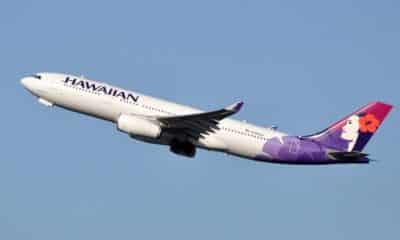Aviation
How Volocopter’s ‘flying taxi’ stations will be running by 2028

How Volocopter’s ‘flying taxi’ stations will use an elaborate system of conveyor belts and lifts to handle 10,000 passengers each day by 2028.
The future of travel has been unveiled by Volocopter – and it seems remarkably efficient. The German flying car start-up has released a video that shows its vision of an urban ‘air taxi’ system that could handle 10,000 passengers each day. The system features elaborate ‘Volo-port’ stations perched on top of skyscrapers that are equipped with conveyor belts, swappable battery packs and lifts to speed up transfer of passengers. This means aircraft are always fully charged and ready to go, according to the company, which claims these futuristic landing pads could be commercially viable for normal people. The company hopes to have a prototype station in place next year but predicts that it will take around ten years before a city-wide system is in place.
The Stuttgart-based start-up’s ambitious plan is to create circular launchpads on the top floor of skyscrapers in cities from where the electric aircraft would take off and land, writes the Verge. They would have a conveyor belt that would transport the vertical takeoff and landing (VTOL) aircraft into an indoor hanger.
From there, they would moved to a garage where maintenance work can be carried out. The system would be so efficient the company claims 1,000 passengers could board and disembark every hour.’It’s about mass transportation of people and how it can be done in a safe way and with what infrastructure,’ Alexander Zosel, Volocopter’s co-founder and chief innovation officer, told the Verge. Mr Zosel said the Volocopter aircraft would need to land every 30 seconds. Having such high volume is important if the company is able to handle lots of passengers and therefore be affordable.
Initially, the taxis would only fly over a short distance with flight times of around 30 minutes and a maximum range of 17 miles (27km). However, some have doubts about how feasible this technology will be – most batteries are still far off offering the power-to-weight ratio required to take off. The company has demonstrated its capabilities in Germany and Dubai where it believed the company is most likely to launch its first service. More recently it announced it partnership with Intel in CES at Las Vegas.
The company stunned attendees during Intel’s keynote by flying the drone right onto the stage, in what a spokesperson admitted was a ‘ballsy’ move. In a presentation about Volocopter’s craft, an exhibitor said it is the ‘world’s first autonomous air taxi.’The craft completed the first unmanned test flight in Dubai this past autumn. ‘Potentially in years to come, you would be able to take your phone out and pull up a transportation application, and similar to what you do with a taxi today, summon this to your location, hop in, tell it where you’re going. ‘And it would autonomously fly you to that location, no pilot required. It’s a safe, reliable form of transportation’, the exhibitor said. The Volocopter craft ‘is essentially a scaled-up super drone,’ he noted. It is fully electric, allowing for zero emission travel. And, it’s quiet enough to be operated in an urban environment.
Volocopter relies on a system of ‘redundancies’ to ensure its safety, meaning there are many propellers, batteries, and motors to compensate in case one goes out. With Intel’s flight control technology and a ‘myriad of sensors,’ the craft is ‘constantly analysing environmental data to ensure those redundancies,’ a Volocopter exhibitor explained.
There are 18 independent motors and propellers, but ‘if that seems like way too many, what it allows for is, you can lose a propeller or several of them and still maintain your flight.’There are nine batteries, ensuring the same type of back-up. According to the firm, rides in the flying taxis would likely be comparable to a trip in an Uber Black.
Courtesy: DailyMail

Aerospace
India is set to build a central command for the Air Traffic Control system, called ISHAN

India’s air traffic growth has led to increased responsibilities for air traffic control. The Airports Authority of India (AAI) is considering centralizing air traffic control for aircraft, dividing the country into four regions. The goal is to consolidate India’s segmented airspace into a single entity to improve air traffic management (ATM) efficiency, safety, and smoothness.
Recently, the AAI invited expressions of interest to develop a detailed project report for the Indian Single Sky Harmonized Air Traffic Management (ISHAN) initiative in Nagpur. Under this plan, air traffic controllers in Nagpur would handle domestic flights flying above 25,000 feet, eliminating the need for coordination among controllers in different regions.
For domestic regional flights operating above 25,000 feet, control would shift to the central command in Nagpur. This consolidation aims to enhance airline operations, increase flight handling capacity, and reduce congestion and flight times for passengers.
Currently, the AAI provides ATM services over Indian airspace and adjoining oceanic areas, covering over 2.8 million square nautical miles. This airspace is divided into four flight information regions (FIRs) in Delhi, Mumbai, Kolkata, and Chennai, along with a sub-FIR in Guwahati.
FIRs are responsible for providing air traffic services, including weather information, visibility, and search and rescue assistance. The proposed unification under the ISHAN initiative aligns with the projected growth of the aviation industry, which anticipates a doubling of domestic passenger traffic by 2030.
Aviation
Airbus is set to increase the production rate for the A350 as demand surges

Airbus SE is set to boost production of its advanced A350 widebody jet as it capitalizes on rising demand for long-distance travel and wide-body aircraft, amidst the ongoing crisis affecting its competitor Boeing due to issues with the B737 Max.
The surge in orders for Airbus’s A350 aircraft has instilled confidence in the company, prompting them to ramp up production rates. This move is particularly advantageous as Boeing continues to grapple with production quality issues surrounding its 787 and 777x aircraft.
In 2024 alone, Airbus has received 137 orders for the A350, signaling a need to expand manufacturing capabilities to meet customer demands. With 1,277 orders received and 592 aircraft delivered as of April 2024, Airbus is poised to fulfill pending deliveries efficiently.
The European aircraft manufacturer announced plans to increase production of A350 jets to 12 per month by 2028, surpassing earlier projections aiming for 10 per month by 2026. This decision was disclosed alongside the company’s first-quarter figures.
The Asian market is proving lucrative for the A350, with significant orders from airlines like Indigo and Air India, totaling nearly 70 aircraft commitments for the future. Meanwhile, Airbus is progressing with its A220 and A320 programs, aiming for a monthly production rate of 14 and 75 aircraft, respectively, by 2026. Additionally, the long-range A321XLR is anticipated to commence service in the third quarter of the current year.
In contrast, Boeing has been compelled to scale back production due to regulatory pressures aimed at enhancing factory processes. While Airbus anticipates a positive market outlook, Boeing continues to face challenges with FAA certification and quality approvals, resulting in ongoing delays for its 737 Max and 777x models.
Financially, Boeing reported a significant cash burn of $3.9 billion in the first quarter, leaving it with $7.5 billion in cash and short-term securities by the quarter’s end, down from $16 billion at the beginning of the year. Consequently, Boeing’s stock has plummeted by 38% in the year so far, contrasting with Airbus’s 14% gain, marking Boeing’s lowest performance in over a year.
For a full listing including details on customers and regions, as well as historical data for the previous year, go to the download section below.
- March 2024 deliveries: 63 deliveries to 32 customers
- March 2024 gross orders: 137
- 2024 deliveries to date: 142 deliveries to 45 customers
| Single-Aisle | A300/A310 | A330 | A340 | A350 | A380 | TOTAL | |
|---|---|---|---|---|---|---|---|
| Total Orders | 19470 | 816 | 1774 | 377 | 1277 | 251 | 23965 |
| Total Deliveries | 11705 | 816 | 1598 | 377 | 592 | 251 | 15339 |
| Aircraft in Operation | 11007 | 271 | 1482 | 202 | 591 | 234 | 13787 |
Aviation
All passengers killed in plane crash, after pilot let his children to control the plane

When boarding a plane, passengers entrust their safety to the skilled hands of the pilot. However, tragedy struck when one of the flight ended in disaster as all passengers lost their lives in a horrific plane crash.
In 1994, during a flight from Moscow to Hong Kong, tragedy struck as an Aeroflot relief pilot made a fateful decision. In a move that would have devastating consequences, the pilot invited his own children into the cockpit to play with the controls. Little did anyone know, this seemingly innocent gesture would lead to the loss of all 75 lives aboard the aircraft.
It was a seemingly innocent act that led to catastrophic results. The relief pilot, Mr. Kudrinsky, invited his two children, Yana, 12, and Eldar, 15, into the cockpit during the late hours of the night. Little did anyone know, this simple gesture would set off a chain of events that would end in tragedy.
Once in the cockpit, the children were allowed to sit in the captain’s chair and play with the controls, unaware that they should have been disabled as the plane was in autopilot mode.
Eldar, perhaps in a moment of curiosity or innocence, held the control column down for a mere 30 seconds. Yet, in those brief moments, the autopilot disengaged, thrusting the aircraft into manual control.
By the time the pilots regained their seats and attempted to regain control, it was too late. Despite their efforts to pull the plane out of a dive, they overcorrected, causing the flight to climb almost vertically, ultimately stalling it.
Final moment Flight 593 crash
In the final moments, as the pilots struggled to stabilize the aircraft, Flight 593 crashed into the Kuznetsk Alatau Mountain range in southern Russia, completely obliterating the plane and claiming the lives of everyone on board.
Investigations revealed a chilling truth: there was no evidence of technical failure. Instead, the crash was attributed to the unthinkable decision to allow inexperienced hands to manipulate the controls of a commercial aircraft.
The black box recording captured the harrowing sequence of events, providing a grim reminder of the human cost of a lapse in judgment. In just over two minutes, the lives of all on board were tragically short, leaving behind a legacy of sorrow and unanswered questions.




























